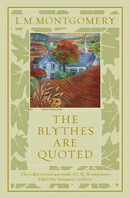

Viking (CAN), hardcover, 9780670063918
Every lifelong reader has at least one treasured childhood book. Mine is Anne of Green Gables, the quintessential novel by one of Canada's most beloved authors, Lucy Maud Montgomery. Although I am no longer part of Montgomery's target audience, I still treat myself to an annual read of her "Anne" series, which has been composed, until now, of eight novels. As of 2009, however, that series has a ninth installment — The Blythes Are Quoted.
Montgomery handed the manuscript for The Blythes Are Quoted to her publisher just days before she died. Though parts of it have been published over the years, 2009 marks its first publication in the state Montgomery intended. Instead of ending her career with a typical novel, Montgomery created a volume of short stories set in and around Glen St. Mary, the home of Gilbert and Anne Blythe. Linking these stories are vignettes starring the Blythe family, featuring the poetry of Anne and her son Walter. These sketches are the strongest sections of The Blythes Are Quoted, as Montgomery returns to the redheaded, imaginative character who defined her career.
Throughout the short stories, Montgomery's strengths as an author become clear: her ability to make a reader care about the people she creates, and her talent with turning conventional plot devices on their heads. The opening story, "Some Fools and a Saint," is anything but a typical Romance plot, as a minister attempts to rid the house of his beloved of an unwelcomed ghost. The resolution of this story is one the reader will never see coming, and it sets the tone for the rest of the collection. While Montgomery's fans may characterize her works as idyllic, cheery tales of humourous misunderstandings, The Blythes Are Quoted is much darker fare. These are stories of death, murder, illegitimate children, supernatural mysteries, and jilted lovers. In "A Commonplace Woman," Montgomery weaves a tragic tale of a woman who had one summer of passionate love, and a lifetime of sorrow. While Anne and Gilbert may have had their happy ending, many of Montgomery's characters did not.
The Blythes Are Quoted is an apt title. Each story, while not directly about Anne's family, contains numerous references to the Blythes. Characters seem obsessed with this family, and whether loved or hated, Anne and Gilbert clearly influence their neighbours. People look to them for advice, seek out their confidence, and aspire to their successful marriage.
Montgomery's last work is not only for her avid fans. Despite the focus on the Blythes, there is much here
for those unfamiliar with Anne's life. The short stories contain sympathetic characters and surprising
plot developments, and many will tug on the reader's heartstrings. For readers who have grown up with
Montgomery's novels, The Blythes Are Quoted is a must‒have. The last few stories, set in
the years just prior to World War II, provide glimpses into the lives of the adult Blythe children.
We see marriages come to fruition, and a new generation of children born. Most importantly, we get one
last glimpse into the life of an iconic character - Anne.